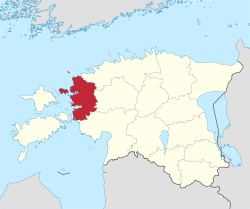Läänemaa
| Lääne County | |||
|---|---|---|---|
| County of Estonia | |||
 |
|||
|
|||
 |
|||
| Country | Estonia | ||
| Capital | Haapsalu | ||
| Government | |||
| • Governor | Innar Mäesalu | ||
| Area | |||
| • Total | 2,383 km2 (920 sq mi) | ||
| Population (January 2016) | |||
| • Total | 24,580 | ||
| • Density | 10.3/km2 (27/sq mi) | ||
| Ethnicity | |||
| • Estonians | 89.2% | ||
| • Russians | 8% | ||
| • other | 1.8% | ||
| ISO 3166 code | EE-57 | ||
| Vehicle registration | S | ||
| Website | www |
||
| Rotalia | ||||||||||
| Läänemaa | ||||||||||
|
||||||||||
|
Ancient Estonia in 1214.
|
||||||||||
| Capital | Lihula | |||||||||
| Languages | Proto Estonian | |||||||||
| Religion | Estonian paganism, Thor cult | |||||||||
| Government | Council of Elders | |||||||||
| History | ||||||||||
| • | Established | Viking Age | ||||||||
| • | Disestablished | 1224 | ||||||||
|
||||||||||
Lääne County (Estonian: Lääne maakond), or Läänemaa (literally "Western land"; German: Wiek, Latin: Rotalia), is one of 15 counties of Estonia. It is located in western Estonia and borders the Baltic Sea to the north, Harju County to the north-east, Rapla County to the east, Pärnu County to the south, and the island counties of Saare and Hiiu to the west. In January 2009 Lääne County had a population of 23,810 – constituting 2.0% of the total population in Estonia.
The County Government (Estonian: Maavalitsus) is led by a Governor (Estonian: maavanem), who is appointed by the Government of Estonia for a term of five years. Since 15 December 2011, the governorship has been held by Innar Mäesalu.
The county is subdivided into municipalities. There are one urban municipality, Haapsalu (Estonian: linn – town) and nine rural municipalities (Estonian: vallad – parishes) in Lääne County.
Urban municipality:
Rural municipalities:
In the first centuries AD political and administrative subdivisions began to emerge in Estonia. Two larger subdivisions appeared: the parish (Estonian: kihelkond) and the county (Estonian: maakond). A parish consisted of several villages. Nearly all parishes had at least one fortress. The defense of the local area was directed by the highest official, the parish elder. A county was composed of several parishes, also headed by an elder. By the 13th century the following major districts had developed in Estonia: Saaremaa (Osilia), Läänemaa (Rotalia or Maritima), Harjumaa (Harria), Rävala (Revalia), Virumaa (Vironia), Järvamaa (Jervia), Sakala (Saccala), and Ugandi (Ugaunia).
...
Wikipedia



